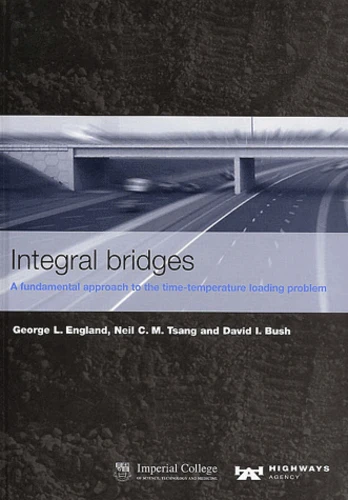Integral Bridges. A Fundamental Approach To The Time-Temperature Loading Problem
Par : , ,Formats :
- Paiement en ligne :
- Livraison à domicile ou en point Mondial Relay indisponible
- Retrait Click and Collect en magasin gratuit
- Réservation en ligne avec paiement en magasin :
- Indisponible pour réserver et payer en magasin
- Nombre de pages152
- PrésentationRelié
- Poids0.805 kg
- Dimensions21,5 cm × 30,5 cm × 1,5 cm
- ISBN0-7277-2845-8
- EAN9780727728456
- Date de parution01/01/2000
- ÉditeurBritish Nuclear Energy Society
Résumé
Integral bridges have become increasingly popular in the UK over recent years. Problems and costs associated with failed expansion joints in conventional bridges not only make integral bridges a cost-effective option but also means they have longer lifespans that their counterparts. The Highways Agency standards now require that, wherever possible, all new bridges of less than 60 m length should be of integral form.
The growing importance of integral bridges has highlighted the need for more information and guidance to assist in improving bridge design. This book presents the results of research commissioned by the Highways Agency into the thermally induced soil/structure interaction created by environmental temperature changes and the associated cyclical displacements imposed on the granular backfill of bridge abutments. It :
develops a better theoretical understanding of temperature-induced cyclic displacements ; in particular the strain ratcheting in backfill soil in contact with a 'stiff' structure, identifies the governing soil parameters and examines their influence, develops numerical modelling procedures to predict soil behaviour, identifies and quantifies the controlling features of bridge structures relevant to the interaction problem
This book provides essential information for bridge designers to aid their understanding of the cyclical changes in backfill pressures and settlement due to diurnal and annual changes in bridge deck temperature - a crucial factor when designing integral bridges.
Integral bridges have become increasingly popular in the UK over recent years. Problems and costs associated with failed expansion joints in conventional bridges not only make integral bridges a cost-effective option but also means they have longer lifespans that their counterparts. The Highways Agency standards now require that, wherever possible, all new bridges of less than 60 m length should be of integral form.
The growing importance of integral bridges has highlighted the need for more information and guidance to assist in improving bridge design. This book presents the results of research commissioned by the Highways Agency into the thermally induced soil/structure interaction created by environmental temperature changes and the associated cyclical displacements imposed on the granular backfill of bridge abutments. It :
develops a better theoretical understanding of temperature-induced cyclic displacements ; in particular the strain ratcheting in backfill soil in contact with a 'stiff' structure, identifies the governing soil parameters and examines their influence, develops numerical modelling procedures to predict soil behaviour, identifies and quantifies the controlling features of bridge structures relevant to the interaction problem
This book provides essential information for bridge designers to aid their understanding of the cyclical changes in backfill pressures and settlement due to diurnal and annual changes in bridge deck temperature - a crucial factor when designing integral bridges.

